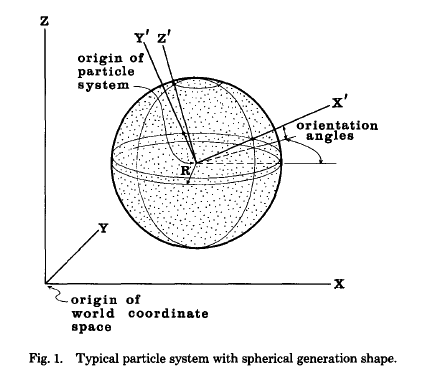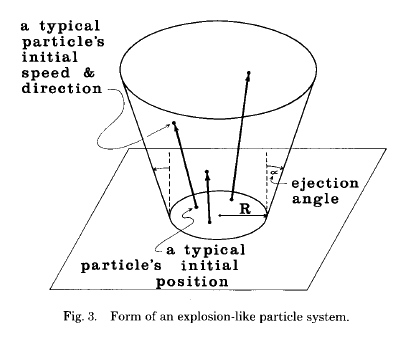2007. 5. 20. 01:20
Method/VFX
http://doi.acm.org/10.1145/357318.357320
 invalid-file
invalid-file
links:
LucanFilm Ltd.
Siggraph: Particle Systems
1
The representation of particel systems :
Advantages of the particle system over classical surface-oriented techinique :
2. BASIC MODEL OF PARTICLE SYSTEMS
frame buffer =>
2.1 Particle Generation
2.2 Particle Attributes
mean values like MeasSpeed, maximum variations like VarSpeed of below:
 More complicated generation shapes based on the law of nature or on chaotic attractors have been envisioned.
More complicated generation shapes based on the law of nature or on chaotic attractors have been envisioned.
eg. streaked spherical shapes => motion-blur particles
2.3 Particle Dynamics
2.4 Particle Extinction
(1) Explosions and fire, the two fuzzy objects we have worekd with the most, are modeled well with the assumption that each particle can be displayed as a point light source. (Other fuzzy objects, such as clouds and water, are not.)
(2) Since particles do not reflect but emit light, shadows are no longer a problem.
2.6 Particle Hierarchy
3. USING PARTICLE SYSTEMS TO MODEL A WALL OF FIRE AND EXPLOSIONS
The Genesis Demo sequence from the movie Star Trek II: The Wrath of Khan was generated by the Computer Graphics project of Lucasfilm Ltd.
 The initial direction of the particles' movement was constrained by the
system's ejection angle to fall within the region bounded by the
inverted cone. As particles flew upward, the gravity parameter pulled them back down to the planet's surface, giving them a parabolic motion path. The number of particles generated per frame was based on the amount of screen area covered by the particle system.
The initial direction of the particles' movement was constrained by the
system's ejection angle to fall within the region bounded by the
inverted cone. As particles flew upward, the gravity parameter pulled them back down to the planet's surface, giving them a parabolic motion path. The number of particles generated per frame was based on the amount of screen area covered by the particle system.
Varying the mean velocity parameter caused the explosions to be of different heights.
The rate at which a particle's color changed simulated the cooling of a glowing piece of some hypothetical material.
ref. Tom Duff
cf. seed value
4. OTHER PPLICATIONS OF PARTICLE SYSTEMS
4.1 Fireworks
 invalid-file
invalid-file
Willian T. Reeves <Particle Systems—a Technique for Modeling a Class of Fuzzy Objects>, ACM Transactions on Graphics, Vol.2, no.2, April 1983, Page 91-108
links:
LucanFilm Ltd.
Siggraph: Particle Systems
1
Particle systems model an object as a cloud of primitive particles that define its volume.
Stochastic processes are used to generate and control the many particles within a particle system.
The representation of particel systems :
- as clouds of primitive particles that define its volume (not by a set of primitive surface elements)
- depending on time (;changing form and moving with the passage of time)
- using stochastic processes (to create and change an object's shape and appeareance)
Advantages of the particle system over classical surface-oriented techinique :
- A particle is a much simpler primitive than polygon.
- efficiency of computation time
- easier removing temporal aliasing effects (by Motion blurring of fast-moving objects)
- The model definition is procedural and is controlled by random numbers.
- efficiency of human design time (to obtain a highly detailed model)
- ability to adjust the level of detail (to suit a specific set of viewing parameters)
- fractal surfaces
- It is easier to model "alive" objects changing form over a period of time.
keywords:
image synthesis
stochastic process
Stochastics
fractal surfaces
procedure
random numbers
stochastic modeling
fractal modeling
image synthesis
stochastic process
Stochastics
fractal surfaces
procedure
random numbers
stochastic modeling
fractal modeling
2. BASIC MODEL OF PARTICLE SYSTEMS
A particle system is a collection of many minute particles that together represent a fuzzy object. Over a period of time, particles are generated into a system, move and change from within the system, and die from the system.
frame buffer =>
during each interval of time = at a given frame
2.1 Particle Generation
NParts_f = (MeanParts_sa_f + Rand()*VarParts_sa_f)*ScreenArea
MeanParts_sa_f = InitialMeanParts_sa + deltaMeanParts_sa*(f-f_0)
2.2 Particle Attributes
initial position => the origin of a particle system
initial velocity
initial color <= average RGB values and the maximum deviation from them
initial transparency
initial size
shape => a region of newly born random particles about its origin
lifetime
A particle's initial color, transparency and size are determined byinitial velocity
initial color <= average RGB values and the maximum deviation from them
initial transparency
initial size
shape => a region of newly born random particles about its origin
lifetime
mean values like MeasSpeed, maximum variations like VarSpeed of below:
InitialSpeed = MeanSpeed + Rand()*VarSpeed

eg. streaked spherical shapes => motion-blur particles
2.3 Particle Dynamics
2.4 Particle Extinction
- when a particle's lifetime reaches zero
- when the intensity of a particle, calculated from its color and transparency, drops belowa specified threshold
- when a particle moves more than a given distance in a given direction from the origin of its parent particle system
(1) Explosions and fire, the two fuzzy objects we have worekd with the most, are modeled well with the assumption that each particle can be displayed as a point light source. (Other fuzzy objects, such as clouds and water, are not.)
(2) Since particles do not reflect but emit light, shadows are no longer a problem.
2.6 Particle Hierarchy
3. USING PARTICLE SYSTEMS TO MODEL A WALL OF FIRE AND EXPLOSIONS
The Genesis Demo sequence from the movie Star Trek II: The Wrath of Khan was generated by the Computer Graphics project of Lucasfilm Ltd.

Varying the mean velocity parameter caused the explosions to be of different heights.
The rate at which a particle's color changed simulated the cooling of a glowing piece of some hypothetical material.
When a motion picture camera is used to film live action at 24 frames per second, the camera shutter typically remains open for 1/50 of a second. The image captured on a frame is actually an integration of approximately half the motion that occurred between successive frames. An object moving quickly appears blurred in the individual still frames.
ref. Tom Duff
cf. seed value
4. OTHER PPLICATIONS OF PARTICLE SYSTEMS
4.1 Fireworks
'Method > VFX' 카테고리의 다른 글
| <Shell Texture Functions> (0) | 2007.06.28 |
|---|---|
| Dan B. Goldman <Fake Fur Rendering> (0) | 2007.06.26 |
| Rhythm&Hue: Hair Render (0) | 2007.06.26 |
| <Rendering Generalized Cylinders with Paintstrokes> (0) | 2007.06.26 |
| <Simulating Multiple Scattering in Hair Using a Photon Mapping Approach> (3) | 2007.06.18 |
